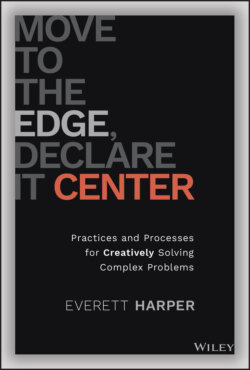Читать книгу Move to the Edge, Declare it Center - Everett Harper - Страница 10
Introduction
ОглавлениеOnce in a generation, there is an event that fractures our experience. The summer of 2020 offered three: protests against racial injustice, massive forest fires in the western United States, and a worldwide pandemic. We can't unsee the knee on George Floyd's neck, supernatural orange‐smoke skies, or the faces of intubated elders dying of COVID alone.
Many of us had to respond to these unprecedented events and make decisions without guidelines or playbooks. Should we ask people to keep working while they're at risk of exposure to COVID? How do we support our teammates during the workday, while they are simultaneously acting as elementary school teachers to their children? Let's be honest – how many of us froze when we didn't know the answer to those questions? I know I did.
We're all susceptible to these responses. Some are rooted in neurochemistry – the well‐known flight‐or‐fight response. But others are rooted in our inherited leadership and management models, based on nineteenth‐century factories, where systems were well understood and problems had a singular “right answer.” We've been rewarded since kindergarten for raising our hand first with the right answer, preparing us to be “decisive” adult leaders.
But twenty‐first‐century problems like racial injustice, climate change, and pandemics are complex. The key property of complex systems is that they are not well understood, there are many unknowns, and problems often do not have a singular right answer. As a result, there is the risk of causing unintended harm. In short, the nineteenth‐century management model is a mismatch for today's leaders navigating complex systems. Many of us know it.
In the early stages of the COVID pandemic, as we realized that the impact was not measured in weeks, but months, I compared strategies with highly experienced, successful leaders. Out of the public spotlight, they were anxious and flummoxed, and they finally admitted, with grief and exhaustion, “I don't know what to do. I don't know what to say. I don't have the right answer.” The fissures that opened this decade are a vivid wake‐up call that the “new normal” is complex, and we need new mindsets, processes, and practices to match.
Move to the Edge, Declare It Center is a framework to help leaders of organizations and teams navigate through complex problems when they don't know the “right” answer and there's no predetermined plan, playbook, or procedure. Move to the Edge is a set of practices, processes, and infrastructure to address complex problems, and Declare It Center is a set of methods to systematize, scale, share, and sustain the best approaches throughout an organization.
This book emerges from two distinct sources. First, from my experience as CEO and co‐founder of my company, Truss. Since 2011, we have developed human‐centered software to help our clients navigate complex, global, consequential problems, from helping to fix Healthcare.gov to modernizing supply chain and delivery logistics systems for some of the largest organizations in the world. We built a company that's been remote‐first for over a decade, exceeds our industry in diversity and inclusion, and is anchored by a values‐driven culture that helped us stay connected through the pandemic.
The second source is a lifetime of being on the edge, navigating the pursuit of excellence from the distinct vantage point of being an outsider. While I have a history of firsts – first in my family to college, first NCAA National Champion in any sport for Duke University – as a Black man in the United States, those firsts do not protect me from being a target of racial violence and discrimination. Every “routine” traffic stop has the potential for a deadly outcome, and despite being the keynote speaker at the TechStars startup conference, I was singled out by an armed security guard at the entrance, “Do you belong here?”
For me and other outsiders, navigating uncertainty is first a survival skill, then an expertise, and finally a gift. But it comes at a cost – the pressure and weight can deplete one's energy and lead to burnout. To avoid this, I've centered on different Interior Practices to prepare me for making high‐stakes decisions under stress. In uncertain times with complex problems, leaders need Interior Practices as a companion for their Exterior (organizational) Practices. Move to the Edge, Declare It Center is a framework that integrates both, and I will share these practices in depth throughout this book.
We're living in a new normal. We have urgent, complex challenges to address, and twentieth‐century tools don't work for twenty‐first‐century problems. Leaders need to approach today's complex systems with a different mindset – led by curiosity and experimentation – while building systems to scale, share, and sustain their best solutions. Move to the Edge, Declare It Center is a framework of exterior and interior practices that will enable you to make better decisions under uncertainty and complexity.
